I've decided to transition to living as a woman 24x7. That's big news, at least for my friends and me. A lot of thought and emotion goes into a decision like this. Just talking about that would be an article in itself! But I will briefly discuss what led me to this decision and how I feel about it. I think it's essential to give some context to what I want to write about, which is the practical, medical, and surgical side of a decision like this.
The Emotional Context.
In my autobiographical essay "A Bimbo's Progress", I wrote about how I came to realize that I was transgender and described my efforts to use "fusion" therapy to balance my life as a man with my life as a transgender woman. You may feel super happy when you are living as a woman. But is that because you are meant to be a woman or because you have managed to escape the stresses of your daily life? If your bank makes a mistake, you show up to the bank as your birth gender and fight with them. But when you are in your trans mode, you don't go to the bank and fight. It's time to party. Of course, you're happier. So if, because of these experiences, you decide you are trans and start living a 24x7 lifestyle as another gender based on these experiences, it might not work out as you expect it to.
The idea behind fusion therapy is to bring the stressful, unpleasant things you may not like into your trans life. It's a deliberate "poisoning of the cool aid," so you compare apples with other apples, not apples with oranges. I tried it, and it seemed for a while that I was reasonably OK with leading a double life. Bringing my life stresses into my life as a woman made both lives equally satisfying. Or so it seemed.
Enter the PANDEMIC.
The isolation of the pandemic removed most of the need for me to present as a male. Some of my male public activities got transferred to things like Zoom, but that took up a small fraction of the time. The result was that I could (and did) remain as a woman for days or weeks. In other words, the ratio of time I spent as a man to the time I spent as a woman suddenly flipped. Surprisingly, I discovered I resented being forced back into my male persona/look/role. Coincidentally, my life partner was pregnant and had much to deal with, so I was thrown even more onto my own resources. As I sat there, marinating entirely in my own sauces for the first time in a long time, it became apparent that I was happier living as a woman, no matter who I was with or what I was doing.
But why Surgery?
Surgery is expensive, painful, and potentially dangerous. So why have it? If dressing as a woman makes me feel better, why not stick with that? Because putting on a dress without doing 4 hours of makeup makes me feel worse. It has the effect of increasing my already sizeable dysphoria instead of reducing it. It highlights how far I am from what I want to be. And I don't want to do daily four-hour makeup sessions for the rest of my life.
And even if I did, as I've evolved, I've discovered that some looks are beyond my reach without surgery. For example, I'd love to do lighter makeup looks. But those don't provide enough contour to feminize my face. I need an essentially feminine bone structure to make those work. And even though I've spent ridiculous amounts of money on prosthetics, low-cut blouses or dresses are still out because prosthetic breasts are impossible to disguise completely.
And hey, finally, after a while, you get tired of being disgusted with how you look when you wake up. It would be nice to wake up looking right. More than anything, that's what I learned from the pandemic.
This decision was not reached in a vacuum. I've reached a point where I want my life to change in ways that do not concern my look or gender. I will be dropping many of the activities that required me to appear as a man, and I will be moving to a remote area where almost no one knows me. That's convenient for my gender change, but that's a convenient coincidence. I would make those changes even if I didn't transition. And I will still be busy. In fact, I expect to be even busier than I am now, and almost all of it should be compatible with my transition. For the parts that aren't, anything that needs to be conducted by people who don't know about my transition must be over the phone or not at all.
So that's the short story. Maybe I raised more questions than I answered. If so, send me an email or something. Meanwhile, let's get on with the practical stuff.
The Medical Stuff
If you decide to go the 24x7 surgical route, there is no shortage of procedures. The top three are
- Facial Feminization Surgery
- Breast Implants (top surgery)
- Vaginoplasty (bottom surgery).
There are certainly others, such as hip and butt enhancements, but these are the big ones.
You might be interested in how many trans people have these surgeries. I know I am. Across all trans people, top surgery is more common than bottom surgery - it's about twice as common. 8-25% of trans people have top surgery, and 4-13% have bottom surgery. Transgender women (biological men) seek out facial surgeries at a rate of 3-8%, which are much less common among transgender men (biological women). This data comes from a paper at PubMed that talks about the trends. It's interesting.
Women with masculine features have a much rougher time than men with feminine features. There are entire books written about masculine-looking cis-women being harassed by other women and legal authorities over bathroom use, for example. So it's not surprising that trans men don't flock to plastic surgeons. But by the same token, I'm surprised more trans women get top surgery than FFS. The last thing I want is to walk around with a masculine face and big boobs. I suspect it has more to do with external factors than preferences. FFS (Facial Feminization Surgery) is vastly more expensive and tougher on the patient than top surgery. My FFS surgery costs six times more than my breast surgery and will take around 6 hours, while my breast surgery will take about four hours. FFS requires an overnight hospital stay and a 12-day recovery period. You can go home after breast surgery, see the results immediately (although they do improve a bit with time), and the recovery period is a matter of weeks. Finding a surgeon who can do breast implants is also much easier. FFS surgeons are extremely rare, and good ones are even harder to find. So perhaps it's not so surprising after all.
Taking the big three one by one, let's start with the one I'm not going to get:
Vaginoplasty
This surgery (and phalloplasty, the equivalent one for transmen) is undoubtedly the surgery most associated with being transgender in the public's mind. But as you saw from the data, it's relatively rare. Some of the most prominent and well-known transgender women (such as Gigi Gorgeous and Blair White) haven't had the surgery.
Unlike FFS and top surgery, I don't think bottom surgery is quite there yet. I have friends who have had it, and I've seen the results. They are my friends, and I am delighted for them if they are happy. Speaking only for myself, I wouldn't be as pleased with the results that I saw.
There are also troubling statistics about depression and even suicides after bottom surgeries. Suicides are always multi-factorial, but that's still something to think about. And post-surgical care for bottom surgery is measured in years. You must dilate the opening daily, with possible dire consequences if you miss a day. So, thanks but no thanks. For me, out of site is out of mind. I can tuck and forget it, or wear clothes where my stuff doesn't show.
Now that I've told you what I'm not doing let's discuss the who and what of my plans
The What: FFS
FFS is an incredibly demanding field. To do it properly requires training in multiple specialties:
- Soft Tissue alterations (ENT's).
- Lower skull modifications (maxillofacial surgeon)
- Upper skull modifications (craniofacial surgeon)
While you see FFS procedures advertised by ENTs and other soft tissue plastic surgeons, I do not believe it is possible to completely feminize your face without altering the bones of the skull. You need someone who can do upper and lower skull modifications (craniomaxillofacial surgeons). You can get facelifts, browlifts, and rhinoplasties ("nose jobs") from soft-tissue plastic surgeons. These procedures will make you look better and can feminize you to a degree, but they won't change the shape of your forehead and brow ridge or alter the contour of your chin and jaw. Anyone who has learned to feminize themselves using makeup knows how important it is to alter the shape of these facial areas. That's why I say there is no way a complete FFS can be performed without altering the structure of the skull.
These types of surgeries are relatively recent. It was pioneered by a French surgeon named Pierre Tessier who is considered the father of these disciplines and did the first public demonstrations of them in 1967. (For comparison, open heart surgery was first done in 1955.) He was an amazing and fascinating man who changed the medical landscape enormously. I think you will really enjoy the linked article!
I will deal with the specific procedures when discussing what I've decided to do, which is basically every available procedure. Meanwhile, let's deal with the important question of who will do it to me.
The Who: Choosing your surgeon
I considered several surgeons, all of whom are highly regarded, world-class surgeons. A decision like this is highly personal, and I would probably have been happy with any of them. So in the following comments, I want to stress that I intend no disrespect to the doctors or their patients. We're lucky to have this pool of talent available to us to choose from!
I was initially interested in doctors in other countries because even including the cost of travel, American medical prices are so high that it's still much cheaper to have procedures done in other countries. This is sometimes called "medical tourism." The problem with medical tourism is liability: If something doesn't go well, it can be much harder to find a legal remedy should you require it. I looked at several different surgeons in multiple countries, finally narrowing it down to two candidates: The Facial Team in Spain(YouTube Channel) and the 2Pass Clinic (YouTube Channel), which is in Belgium but conducts consultations in many different countries.
I spent many hours talking to their patients online and watching video interviews of a few of their many successful transitioners. I was particularly impressed with the 2pass Clinic and seriously considered them. Ultimately, it wasn't enough to offset my worries about having such a significant surgery done outside the U.S. But if you are in the EU and interested in transitioning, I would encourage you to consider them.
Having decided to choke down the American medical fees, I started researching American surgeons. I narrowed my list down to three:
- Harrison Lee, in New York City and Beverly Hills, CA
- Dr. Spiegel, in Boston
- Dr. Ousterhout, in San Francisco, CA
Dr. Lee is a world-class craniomaxillofacial surgeon probably best known in the trans community for being chosen by Caitlyn Jenner for her FFS. He was also chosen by Nikita Dragun, the YouTuber, to do her first FFS. Nikita filmed a lot of her procedure and released it to the public:
Other patients of Dr. Lee have followed in Nikita's footsteps, and I've watched several of their videos. It takes a lot of courage to do that, and I'm very grateful to have these. I found most of them very helpful. If you are considering FFS, I highly recommend you watch a few, if only to understand the pain and suffering you are in for.
I studied the various videos of Dr. Lee and his patients carefully and looked at their results. Dr. Lee did a beautiful job on Jenner, but a key element was missing for me. She has a very long face, a characteristic I share with her, and it's one of the things I want to be fixed. I don't see any change in facial length in her before and after photos. Of course, this could have been her decision, not Dr. Lee's, but it was enough for me to move Dr. Lee to second place on my consultation list. Someone like Nikita Dragun doesn't have this problem, and her transformation is stunning.
Dr. Spiegel is another world-class craniomaxillofacial surgeon with many successful patients. He may be best known for being Gigi Gorgeous's surgeon. Here's her post-surgical testimonial:
I'm a big Gigi fan, and I think we'd all be happy to look that great. So I was pre-disposed to like Spiegel, and I do. He has all the training to do an excellent job, and I love how his patients look. Of course, Gigi started out looking pretty amazing, so much less had to be done to her. I'm not starting from the same place, and I need more done. I'm hoping for a significant change, and perhaps unfairly, I felt Dr. Spiegel would be hard to talk into the more aggressive changes I wanted. I was still considering a consult with him, but I moved him to 2nd place, with Dr. Lee now in 3rd.
This left Dr. Ousterhout. This guy is amazing. He was a student of Tessier, and he single-handedly created the sub-discipline of facial feminization surgery in 1982. He wrote a book about it, which I read several years ago. The only reason I initially put him at the bottom of my list is that he practices on the other side of the country, which is inconvenient. Unfortunately, Dr. Ousterhout had retired by the time I decided to proceed. However, he cared about his legacy and handpicked and trained his successor, Dr. Dechamps-Braly. Dr. Dechamps-Braly is younger than the other surgeons I was considering. But he has had a few hundred patients already and a golden education. When he met Ousterhout, he was already an extremely accomplished surgeon. And Dr. Ousterhout also trained him personally for two or three years before turning his practice over to him.
Dr. Dechamps-Braly also updated Ousterhout's book. The new version is much better and has more current information. I have read it three times, and I highly recommend it: Dr. Dechamps-Braly's book. It is incredibly impressive and detailed.
I also watched some of his patient interviews. I was very impressed with their look. Several of them mentioned how happy they were that he would consider more aggressive procedures, which was music to my ears. I was also impressed by how harmonious the final result was. All the interviews are worth watching, but I especially enjoyed Jamie's:
It's also worth watching a discussion between Dr. Dechamps-Braly and his mentors. It's absolutely fascinating:
Having decided on the order of my consults, the only thing left was to get one and schedule the surgery.
Scheduling
If you want surgery like this, be prepared to wait. I contacted the Deschamps-Braly Clinic a year ago, filled with eagerness, only to learn I would have to wait nearly a year for a consult. I spoke with Robin, the wonderfully professional and kind surgical coordinator. She told me they were currently scheduling surgeries for November 2023. That was 19 months away! If I waited until post-consult, I wouldn't get surgery until sometime in 2024. So I asked if I could reserve a surgery time contingent on a successful consultation. They agreed to hold a surgery date for November 2023 for a small deposit (applicable towards the total cost of my surgery). If we couldn't agree at the consult and the surgery was off, they would refund my deposit, but if I changed my mind or canceled the consult, I would lose my deposit. That sounded reasonable to me.
I consulted with Dr. Deschamps-Braly a couple of days ago, and he's everything I hoped for. He spent over two hours with me, and the discussion was open and honest. After meeting him, it was obvious to me that further consultations would be pro forma, and I finalized my surgical plans at his office before I left.
Waiting times like this are probably typical for the best surgeons. There are not that many people who want these procedures done, but there are extremely few people who are doing them. So if you are thinking about this, I suggest you prepare yourself for a wait. And while you wait, things can happen.
The Changing World
A year ago, when I scheduled my consultation and surgery, America seemed friendlier to transgender people than now. Now there are over 300 anti-transgender bills in various state governments, many of which are passing. It seems to me that various conservative groups are trying to use transgender people, and in particular transgender children, as a wedge issue to ultimately roll back the gains gays and others have made over these years.
At the best of times, doing a transition like this will make you wonder if you are just swapping inner misery and outer peace for inner peace and outer misery. This is something every trans person has to consider, and given the wait times and the turmoil in the world, things can change for the worse (or, the better) while you wait. Remember that before you plunk down your hard-earned cash on deposits.
And now for the enjoyable stuff:
FFS Procedures!
In what follows, I'll try to group the procedures together so they make some sense.
Scalp Advancement, Brow lift, and Forehead Contouring
Women's foreheads are typically smaller than men's. It's impossible to change the vertical size of your forehead because that would impinge on the brain, and you need that to be functional. Instead, they create the illusion of a smaller forehead by moving your scalp and raising your eyebrows (a brow lift).
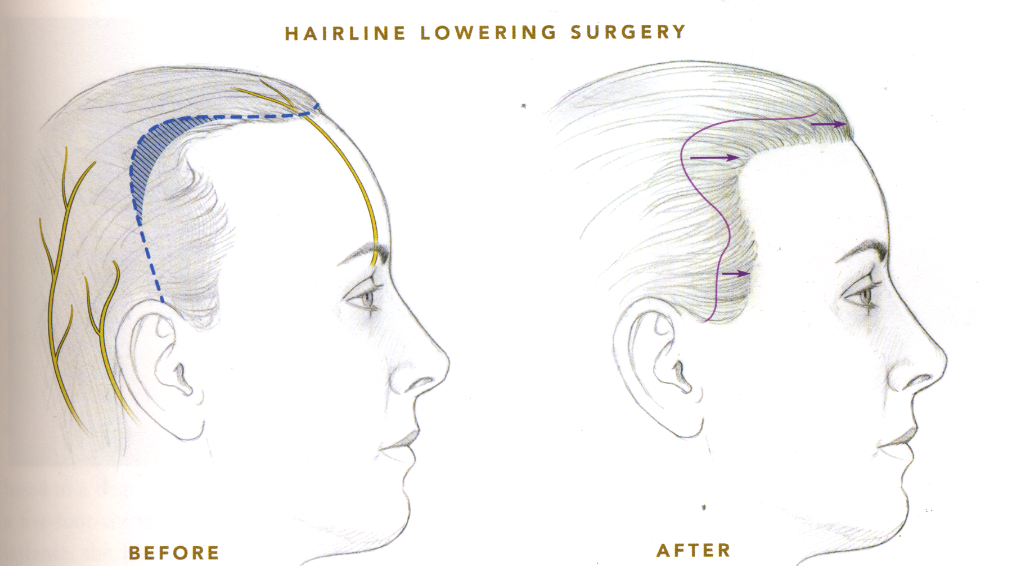
To advance my scalp, they will cut above the hairline, trying to preserve as many hair follicles as possible. The idea is to hide the scar in the hair. The cut follows the hairline, angling back at the sides and finishing behind the ears. A thin fibrous membrane (called the galea) covers the scalp. They can cut that if they need to get more advancement. They pull the scalp forward and then lift the forehead skin to get the eyebrows higher. Once that is done, they trim the extra skin from the forehead and suture everything together.
I may need hair transplants along the incision. Time will tell. Waiting a year to do the transplants increases the likelihood of success. And this procedure can also be repeated in a year if I want an even smaller forehead since the scalp will loosen as it sits in its new position.
Besides being larger, most male foreheads have a sizeable forward projection. When viewed from the side, a male forehead will appear to slope downward and outward as it approaches the eyes. In contrast, a woman's will appear more vertical and rounded. Men also have what is called bossing just above the eyes, which makes male eyes look inset. There is also a flat or just hollow spot slightly above the bridge of the nose.
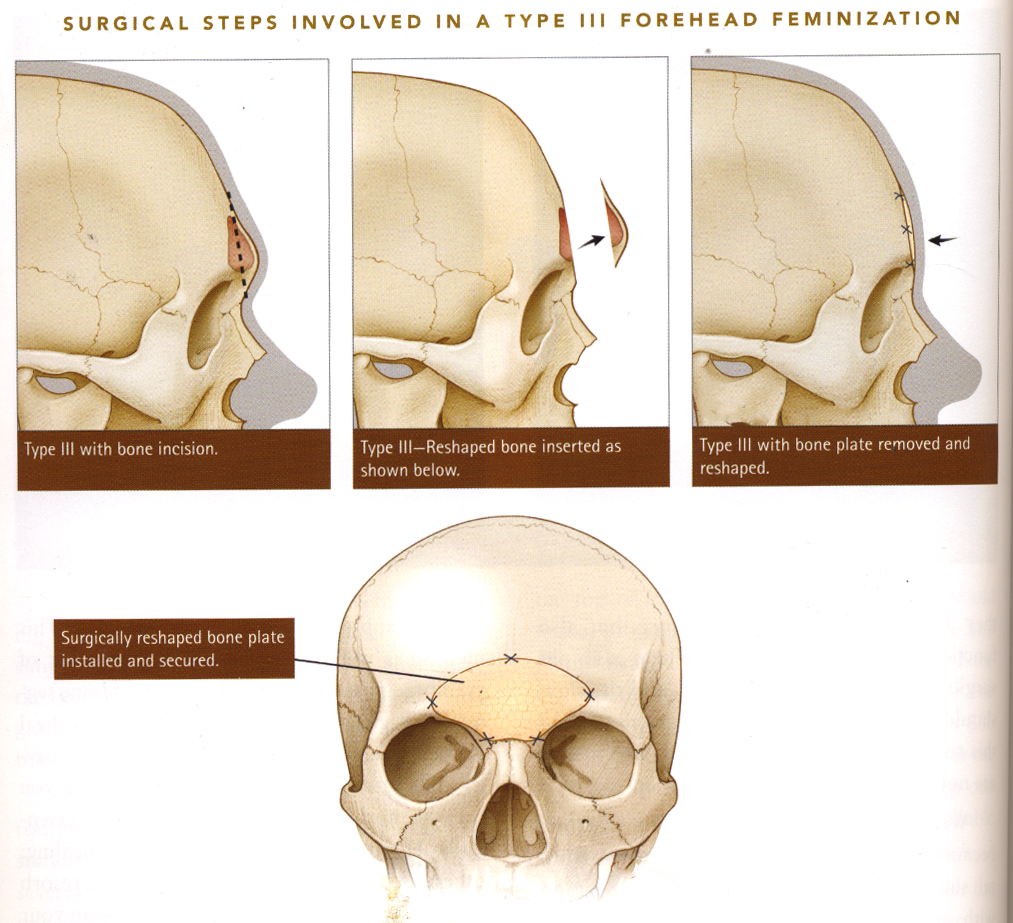
Not all skulls fit into this category, but most do, and mine is one of them. To contour what Ousterhout called a type III forehead, before doing the final suture of the forehead skin, they will remove the part of the forehead that covers the frontal sinus (a hollow area of bone in the forehead), cut out part of the frontal sinus wall and then shape the removed bone, so it fits back. They will also grind down and blend in the bony projections over the eyes and to the side. Then they will complete the procedure by suturing the forehead skin shut.
Temporal Fossa
There is no difference in the temporal fossa between the genders, so this procedure is to make me look prettier. This area is sometimes called "the temple." It is located at the side of the eyes and above the cheekbones. In my case, it looks a bit recessed, which I do not like. There are various ways to correct this, such as augmenting the bone with foreign materials. I have requested that they do fat grafting. My surgeon also preferred this, so we are all good here. The picture below shows the site of all the potential fat grafting areas. I will be adding to most of them.,
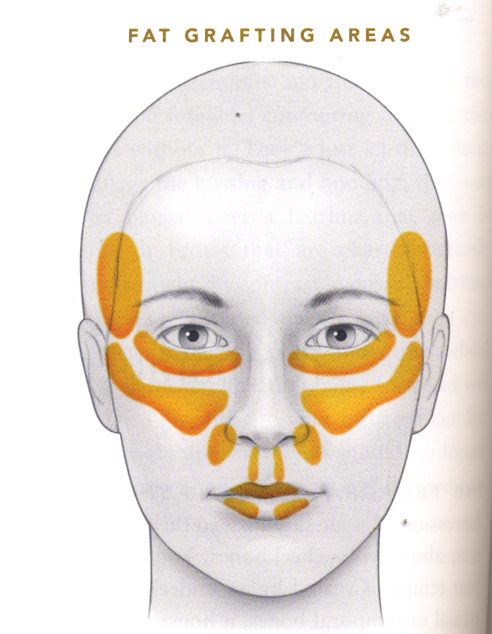
They will harvest the fat inside my thigh. This is nice since that fat is high in stem cells which can help the appearance of skin. They prepare the fat and inject it in minute droplets across the area to be filled, a tiny amount at a time.
Nose Reshaping (Rhinoplasty)
Rhinoplasties are incredibly complex procedures. The big challenge in a Rhinoplasty is to make it look like it belongs on your face. The new nose will also have to look good with my new forehead, cheeks, and lower face.
I selected a few different noses that I liked, and I tried to stick to people whose faces were similarly shaped so the nose could be harmonious with mine. My surgeon will do his best. For more information on rhinoplasties, watch this excellent youtube video, which hits all the main points:
There are two main ways to do it: the closed approach, where the surgeon works completely inside the nose, and the open approach, where the surgeon lifts the skin away from the nose. The advantage of the closed approach is that the scar is left inside the nose. The disadvantage is that the surgeon has limited visibility. Because of this, the closed rhinoplasty has fallen out of favor, and open rhinoplasties are more commonly done.
I think open rhinoplasties lead to better results, and so does my surgeon. Considering that a rhinoplasty on a transgender person is particularly challenging, I am pleased we agree. I'm not especially concerned about the small scar, which should fade over time.
If you want to correct your forehead and nose, they must be done simultaneously. Dr. Deschamps-Braly would probably refuse to break them up into multiple surgeries. This will allow the nose and forehead to be blended together. This blending is crucial at the radix, the little dip where the nose meets the forehead.
Lip Reshaping
Entering the lower face zone, they will also lift and reshape my upper lip. The distance between the upper lip and the nose in men is much larger than in women. In my case, it is huge. So they will cut out some of the skin right below my nose and suture the gap. This will reduce the distance between my nose and lip. It will also have the nice side effect of increasing the size of the vermillion, the red portion of my lip. This is something I want badly.
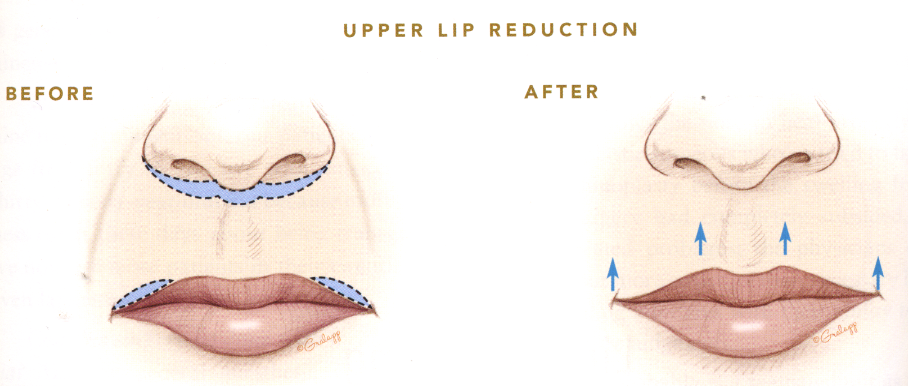
If the upper lip still looks too small (and I have told them I want big lips), they will do some fat grafting in addition to the surgery. No surgery will make the lower lip fuller, so they will also use fat grafts there. See the description of fat grafting in the temporal fossa section for more information on fat grafting.
Another advantage of this procedure is that it will give me a more feminine smile. Women's upper teeth are more exposed than men's, even when they barely open their lips, while men's lower lips are more open. All of these procedures will definitely aid in the feminization process, hopefully making me prettier at the same time.
Jaw and Chin Contouring
My jaw and chin are not so terrible, but could still stand some work. My surgeon and I had a small disagreement over the handling of the chin. He wanted to contour it with a saw or grinder. In addition to the contouring, I think a more complicated procedure, called a sliding genioplasty, would be helpful. In a sliding genioplasty, they make a horizontal slice through the chin, slide the lower slice into an appropriate position, and then fasten it. The picture below doesn't show the genioplasty. This is the contouring. The colored areas will be removed, and the pieces of the chin and jaw will be fastened into place.
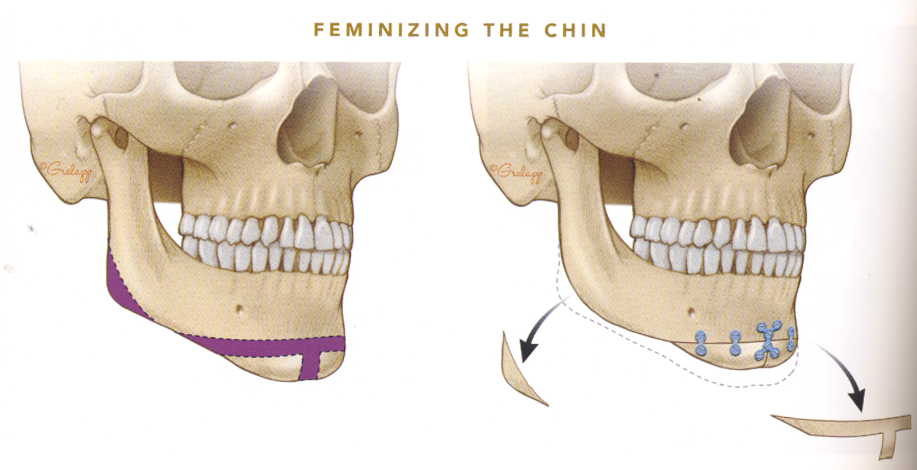
After much discussion, we compromised: he will do a miniature version of the sliding genioplasty. This should also positively affect the appearance of my neck.
The jaw, at the side of your face, is divided into the horizontal and verticle ramus, which meet at the mandibular angle. This is easy to feel by running your finger along your jaw, back towards your ear. In men, they meet at a sharp and bony angle. Mine is already smaller and more feminine than typical but could stand some reduction, so they will be fixing that.
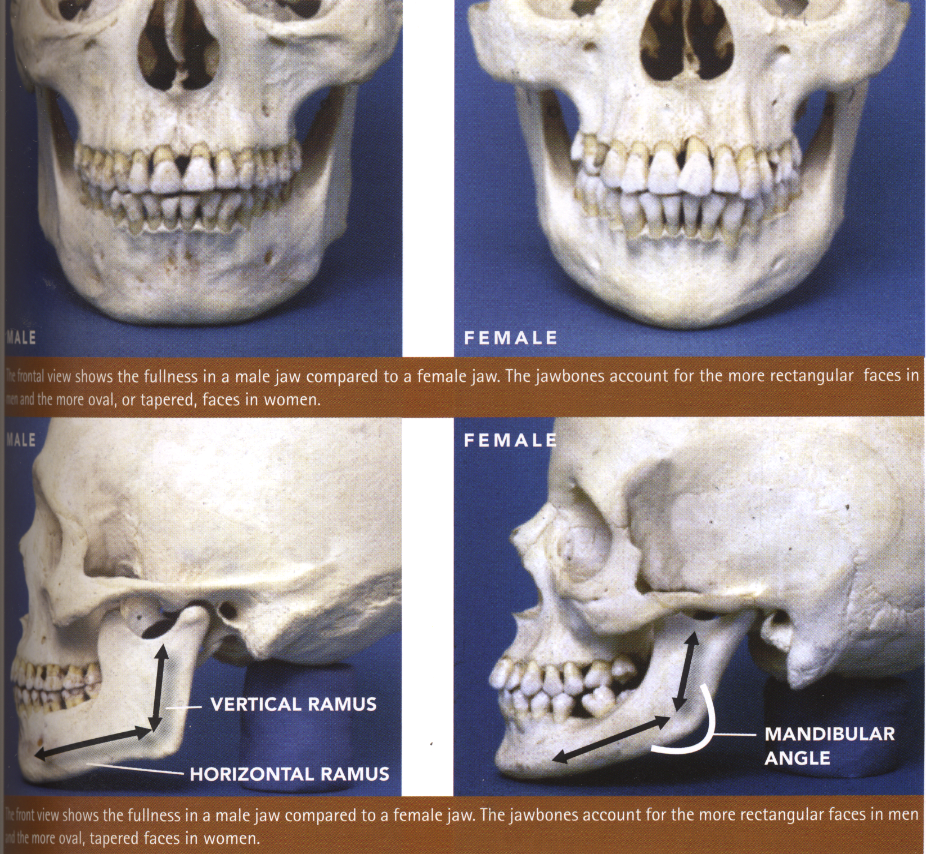
Cheek Contouring
They will also be adding to my cheeks using fat grafting. See the description of fat grafting under the temporal fossa description for more information and a graphic.
Trach Shave
An obvious difference between men and women is the appearance of the "Adam's apple," more properly called the "Thyroid Cartilage." This can be reduced, and since it's such an obvious gender marker, it is one of the most common procedures done. They make an incision in the crease below your chin, then access the cartilage. They reduce it until, hopefully, it is completely flat. The scar is invisible unless someone looks straight up at the bottom of your chin.
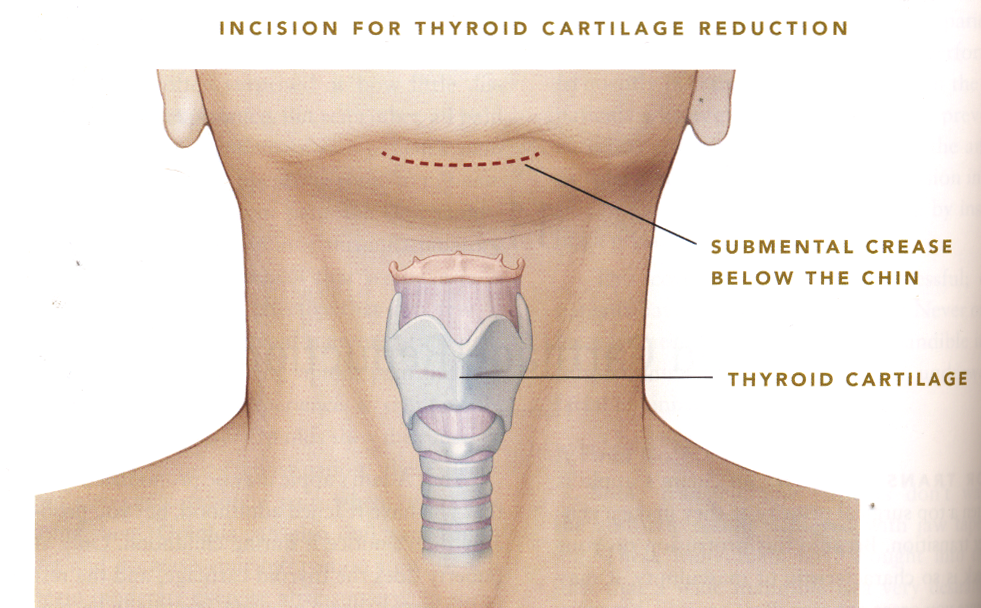
Post surgery
I will spend one night in the hospital. They install lots of drains to let fluid escape from the face rather than puff it up. After that, I am on a liquid diet in a hotel room near my surgeon's office for about 10-11 days, with visits as necessary.
Most swelling should decrease in a few weeks. The jaw area typically takes quite a bit longer. It will be a year or more before the swelling subsides completely and the final results can be seen.
Future Surgeries
Depending on the results, I may want more. Dr. Deschamps-Braly is aggressive but reasonable. You can't replace the skin you have removed. So it may be iterative. It's also very common to need a facelift a year later, and I'm already talking to them about scheduling. As the swelling goes down, your facial skin can be loose and slack. This can also be caused by weight loss, which is common after this surgery.
So stay tuned for more surgical fun down the road. Meanwhile, look at part two, where I discuss my breast enhancement surgery.
Let me know how you feel about all this or if you want to share any questions or experiences!